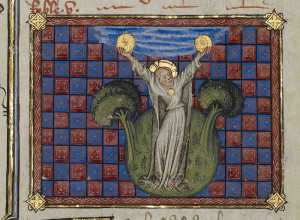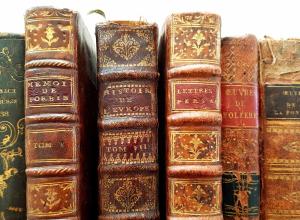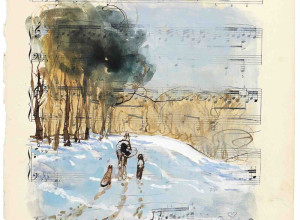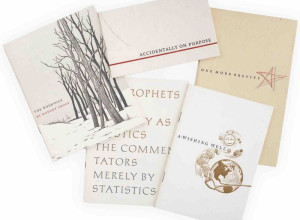The J. Paul Getty Museum Announces Acquisition of Rare Secular Flemish Manuscript

LOS ANGELES -The J. Paul Getty Museum announced today the acquisition of the Livre des fais de Jacques de Lalaing (Book of the Deeds of Jacques de Lalaing), a highly important illuminated manuscript comprising text by Jean Lefèvre de Saint-Remy and a frontispiece by Simon Bening, the leading Flemish manuscript painter of the period. The manuscript also contains 17 lively miniatures attributed to an anonymous painter in the circle of the Master of Charles V. The Livre des fais de Jacques de Lalaing is considered one of the greatest secular manuscripts produced during the last flowering of Flemish illumination in the second quarter of the 16th century. The vivid illuminations, rendered with remarkable detail and vibrant colors, extol the ideals symbolizing the age of chivalry.
Above: Fol. 10v: Simon Bening, The Author in His Study. From the Livre des fais de Jacques de Lalaing by Jean Lefèvre de Saint-Remy (and others). Burgundian Netherlands, ca. 1530-40. Ink, tempera colors, and gold on parchment. 14 1/3 x 10 1/3 in. (36.4 x 26.2 cm).
”The Getty Museum's collection is especially strong in manuscripts of the northern Renaissance, including a number of outstanding masterworks." says Timothy Potts, director of the J. Paul Getty Museum. "With its engaging narrative of a medieval knight’s chivalrous adventures, the Lalaing manuscript brings into the collection a secular work that rivals in artistry, vivacity, and condition our famous devotional illuminations of this period.”
Potts continues, “Of the eight known manuscripts of the Livre des fais de Jacques de Lalaing, only four are illuminated, the Getty version being clearly the most accomplished and sumptuous. For manuscript enthusiasts--and anyone interested in medieval times - this work has everything: the gripping tale of an all-conquering knight, supreme artistry, and a miraculous survival through some 500 years in the same family. It is sure to be much asked for and admired in our galleries.”
The text and illuminations of the new acquisition relate the adventurous life of Jacques de Lalaing (1421-1453), a celebrated knight of the Order of the Golden Fleece and the most famed tournament fighter of the Middle Ages. The miniatures concentrate on Jacques’s unparalleled feats of arms, as he made his way across Europe challenging and defeating most of the prominent knights of his day.
The manuscript’s illuminations begin with a magnificent frontispiece by Simon Bening showing the text’s main author, Jean Lefèvre de Saint-Remy, laboring over the text in his study. This exceptional work displays the exquisite naturalism and bold compositional design that characterize Bening’s style at its very best. The image is defined by the sunlight that spills through the large window at left, creating tantalizing effects of light and shadow across surfaces that vary from stone and wood to fabric and fur. “Bening was responsible for many of the most lauded manuscripts produced during the period, but he worked on relatively few secular works. The frontispiece in Livre des fais de Jacques de Lalaing is among his most accomplished and monumental illuminations,” says Elizabeth Morrison, senior curator of the Department of Manuscripts.
Simon Bening has long been considered the last great manuscript illuminator of the northern Renaissance, and his style dominated production in the first half of the sixteenth century. He specialized in the illumination of prayer books, filled with expansive landscapes, vivid narratives, and his hallmark fleck-like brushwork. Bening also created numerous independent paintings on panel and parchment, which influenced illuminators and panel painters across northern Europe. This is the fourth work by Bening to enter the Getty Museum’s collection, and the first on a secular theme.
The manuscript’s remaining 17 miniatures are attributed to an anonymous painter within the circle of the Master of Charles V, who was the leading Flemish illuminator of the period after Bening. The illuminations are devoted to Jacques’s prodigious victories on the tournament circuit, replete with wondrous chivalric imagery of jousts, festivals, hunts, and battles. The painterly quality seen in the handling of the figures and landscapes, the bright colors, and the dramatically conceived compositions lend the manuscript an exceptional freshness and vivacity. The miniatures revel in the trappings of court life, virtually sparkling with energy and animation.
The famed events of Jacques de Lalaing’s life provided ample dramatic possibilities for the manuscript’s miniatures, ranging from his youthful travels as a knight errant at Europe’s sumptuous courts to his valiant support of Burgundian duke Philip the Good during the revolt of the city of Ghent in the early 1450s. Just weeks before Philip’s final victory in 1453, Jacques was killed by the new technology of artillery fire at the Castle of Poeke, an ironic end to one of Europe’s most acclaimed fighters in hand-to-hand combat. In the manuscript’s final image (fol. 184v), the artist depicts Jacques glancing over his shoulder at the cannonball thundering towards him as he confronts his imminent demise. Jacques’ notoriety had already spread far and wide, but his untimely death soon resulted in his celebration as the most illustrious knight of his age.
The manuscript was commissioned by a member of Jacques de Lalaing’s own family approximately 80 years after his death, no doubt intended as a memorial to the lineage’s most famous ancestor. It passed directly through branches of the Lalaing family for the next five hundred years before emerging on the art market in late 2015.
This work has been acquired in honor of Dr. Thomas Kren, senior curator of the Department of Manuscripts from 1984 - 2010, who last fall retired from the Getty Museum as Associate Director of Collections. A leading scholar in the study of Flemish manuscripts, Dr. Kren was the curator of many manuscript exhibitions at the Getty Museum, including the much heralded Illuminating the Renaissance: The Triumph of Flemish Manuscript Painting in Europe (June 17 - September 7, 2003).
This newest acquisition is expected to go on view this summer in the Museum’s Manuscripts galleries. Details will be announced once confirmed.















